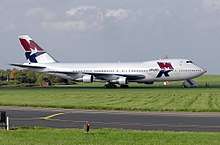MK Airlines Flight 1602
 The aircraft involved in the incident at Filton Airfield, England on 10 October 2004, four days prior to the accident. | |
| Accident | |
|---|---|
| Date | 14 October 2004 |
| Summary | Pilot error due to inadequate company-related management of aircraft |
| Site |
Halifax Stanfield International Airport, Nova Scotia, Canada |
| Aircraft | |
| Aircraft type | Boeing 747-244B/SF |
| Operator | MK Airlines |
| Registration | 9G-MKJ |
| Flight origin |
Bradley International Airport, Windsor Locks, Connecticut, US |
| Stopover |
Halifax Stanfield International Airport, Enfield, Nova Scotia, Canada |
| Destination |
Zaragoza Airport, Spain |
| Passengers | 0 |
| Crew | 7 |
| Fatalities | 7 (all) |
| Survivors | 0 |
MK Airlines Flight 1602 was an MK Airlines Boeing 747-200F cargo flight on a flight from Halifax Stanfield International Airport, Nova Scotia, Canada to Zaragoza Airport, Spain. It crashed on take-off killing the crew of 7.[1]
Aircraft
The Boeing 747-200 was originally manufactured for South African Airways in 1980 as ZS-SAR, making its first flight on October 24 of the same year, and being delivered on November 6. [2] At some point during its service with SAA, ZS-SAR was converted to a freighter. On November 11, 1992, ZS-SAR was leased to Garuda Indonesia as 3B-NAS. Sometime before September 1995, the aircraft was returned to SAA, and in March of 2000, was sold to MK Airlines as 9G-MKJ. [3]
Incident
At 00:03 local time, on October 10, 2004, MK Airlines Flight 1602 took off from Windsor-Locks-Bradley International Airport. The aircraft was loaded with a cargo of lawn tractors, and made an intermediate stop at Halifax at 02:12 to be loaded up with approximately 53,000 kilograms (53 t) of lobster and fish. Flight 1602 taxied to Runway 24 (today, 23) and the takeoff roll was commenced at 06:53:22. When the aircraft reached 130 knots (150 mph) of airspeed , the control column was moved aft to 8.4° to initiate rotation as the aircraft passed the 5500-foot (1,700 m) mark of Runway 24; with 3,300 feet (1,000 m) left on the runway, the aircraft began to rotate. The pitch attitude stabilized briefly at approximately 9° nose-up, with airspeed at 144 knots (166 mph). Because the 747 still had not lifted off the runway, the control column was moved further aft to 10°, and the aircraft responded with a further pitch up to approximately 11°; at this time, a tailstrike occurred. The aircraft was approximately at the 8000-foot (2,400 m) mark and slightly left of the center-line. The control column was then relaxed slightly, to 9° aft. The pitch attitude stabilized in the 11° range for the next four seconds, and the tailstrike abated as a result. With approximately 600 feet (180 m) of runway remaining, the thrust levers were advanced to 92% and the EPRs increased to 1.60. With 420 feet (130 m) remaining, a second tailstrike took place. As the aircraft passed the end of the runway, the control column was 13.5° aft, pitch attitude was 11.9° nose-up, and airspeed was 152 knots (175 mph). The highest recorded nose-up pitch of 14.5° was recorded at one minute and two seconds after takeoff initiation after the aircraft passed the end of the runway at a speed of 155 knots (178 mph). The aircraft became airborne approximately 670 feet (200 m) beyond the paved surface and flew a distance of 325 feet (99 m). The lower aft fuselage then struck an earthen berm supporting an instrument landing system (ILS) localizer antenna 300 meters (980 ft) beyond the end of the runway, separating from the plane. The plane then headed forwards in a straight line for another 1200 feet (370 m), breaking into pieces and bursting into flames when it struck the ground.[4] [5]
Rescue
Over 60-80 firefighters and 20 pieces of apparatus from Halifax Regional Fire and Emergency responded to the call. It took nearly three hours to extinguish the post-crash fire. [6]
Investigation
An investigation into the crash revealed that the flight crew had used the incorrect speeds and thrust setting during the take-off attempt, with incorrect take-off data being calculated when preparing the flight (incorrect V speed calculation, as the result of the crew re-using a lighter take-off weight of 240,000 kg from the aircraft's previous take-off at Bradley, instead of the correct weight of 353,000 kg). The official report blamed the company for serious non-conformances to flight and duty time, with no regulations or company rules governing maximum duty periods for loadmasters and ground engineers, resulting in increased potential for fatigue-induced errors.[7]
MK Airlines disputed the findings, citing the fact that the cockpit voice recorder was too heavily damaged in the post-crash fire to yield any information.[8]
See also
References
- ↑ "Accident MK Airlines Flight 1602 B747 9G-MKJ - Airfleets aviation". Retrieved 19 January 2017.
- ↑ "ZS-SAR". https://saahistory.wordpress.com. Retrieved 14 October 2018. Text " South African Airways - A Complete History " ignored (help); External link in
|website=(help) - ↑ https://aviation-safety.net/database/record.php?id=20041014-0. Missing or empty
|title=(help) - ↑ https://aviation-safety.net/database/record.php?id=20041014-0. Missing or empty
|title=(help) - ↑ "Some Progress in the Halifax 747 Freighter Crash - but the recovered CVR is Useless". Retrieved 19 January 2017.
- ↑
- ↑ "Reduced Power at Take-off and, Collision with Terrain, MK Airlines Limited, Boeing 747-244SF 9G-MKJ, Halifax International Airport, Nova Scotia. Report Number A04H0004" (PDF). Canadian Transportation Safety Board. Retrieved 8 September 2010. (French version)
- ↑ "Probe links crash to fatigue". Retrieved 2018-10-02.
External links
|
| |
|
|
- MK Airlines Flight 1602 final accident report
- MK Airlines Flight 1602 final accident report (in French)
Coordinates: 44°51′44.7″N 63°31′49.83″W / 44.862417°N 63.5305083°W